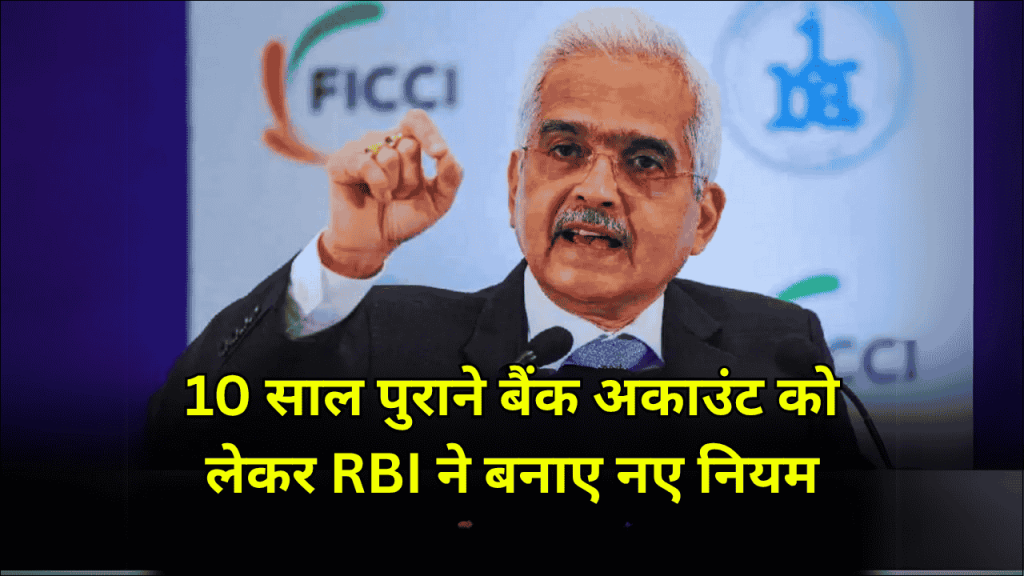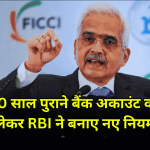
The Reserve Bank of India has recently taken a significant decision by issuing new guidelines for savings and current accounts that have been inactive for more than 10 years. This move brings relief to millions of account holders who haven’t used their bank accounts for extended periods, making it easier for them to reclaim their money.
RBI’s decision has been made keeping customer interests in mind, ensuring that people can easily recover their funds from dormant accounts. These new rules will increase transparency in the banking system and strengthen customer confidence while simplifying the reactivation process significantly.
According to the new regulations, banks must now provide KYC update facilities to reactivate such accounts. This process has been made much simpler and more convenient compared to previous procedures, ensuring no one remains deprived of their money due to inactive accounts.
Simplified KYC Update Process
The RBI’s new guidelines include video identification processes for KYC updates, reflecting the central bank’s adaptation to digital age requirements. This technological improvement eliminates the need for customers to repeatedly visit bank branches, saving both time and effort.
Video KYC facility will be particularly beneficial for elderly customers and those living in remote areas who face difficulties in physically visiting bank branches. The process is designed to be user-friendly and accessible to people with varying levels of technological proficiency.
Additionally, banks are now permitted to use registered Business Correspondents for activating dormant accounts. This arrangement will prove extremely useful for people living in rural and remote areas, making banking services more accessible and promoting financial inclusion.
Business Correspondents can help customers update their KYC near their homes, eliminating geographical barriers and making the process more convenient for account holders across different locations.
Definition and Criteria for Dormant Accounts
According to banking regulations, any bank account with no transactions for the past 10 years is considered dormant or inoperative. This includes accounts where neither deposits nor withdrawals have been made during this period.
If an account has a remaining balance that hasn’t been claimed for 10 years, it’s termed as ‘Unclaimed Deposit’. Such situations typically arise when account holders don’t use their accounts for extended periods or forget about them entirely.
| Account Status | Duration | Definition | Action Required |
|---|---|---|---|
| Active Account | Regular transactions | Normal banking operations | None |
| Inactive Account | 1-2 years no transaction | Limited operations | Simple reactivation |
| Dormant Account | 10+ years no transaction | Completely inactive | KYC update required |
| Unclaimed Deposit | 10+ years with balance | Money transferred to DEAF | Claim process needed |
These situations can occur due to various reasons such as account holder’s death, relocation to another city, or simply forgetting about the account. Sometimes people move to new cities for jobs or business and forget to close their old accounts.
Role of Deposit Education and Awareness Fund
Under current regulations, banks must transfer all balances from dormant accounts to the Deposit Education and Awareness Fund (DEAF). This fund operates under RBI’s supervision and aims to promote depositor interests and financial literacy.
The DEAF is used for financial literacy programs, depositor protection, and awareness campaigns. This system ensures that money from inactive accounts doesn’t go waste but serves public interest while remaining the rightful property of account holders.
When someone claims their dormant account, banks return the money along with applicable interest from the DEAF. This transparent system protects account holders’ rights and ensures their money remains safe even in dormant status.
| DEAF Benefits | Description | Timeline |
|---|---|---|
| Money Safety | Funds remain secure in DEAF | Indefinite |
| Interest Earning | Account continues earning interest | Annual |
| Easy Claim | Simple process to reclaim funds | Variable |
| Financial Literacy | Funds used for public education | Ongoing |
Benefits for Customers Under New Rules
The new RBI rules offer several advantages to customers. The most significant benefit is that reactivating dormant accounts has become much easier than before. Video KYC facility eliminates the need for multiple branch visits, especially beneficial for elderly and disabled individuals.
Digital processes save time and reduce paperwork significantly. The expansion of Business Correspondent services is particularly advantageous for rural areas, ensuring that people in small towns and villages don’t need to travel to big city bank branches.
This arrangement promotes financial inclusion and ensures that people in remote areas can also benefit from their dormant accounts. The simplified process makes banking services more accessible to a broader population.
Bank Responsibilities and Implementation
Under the new rules, banks’ responsibilities have increased significantly. They must now regularly inform customers about their dormant accounts and ensure that the KYC update process remains simple and transparent.
Banks must educate customers about how they can reactivate their dormant accounts and ensure that video KYC and Business Correspondent services are available to all customers without discrimination.
| Bank Obligations | Description | Timeline |
|---|---|---|
| Customer Notification | Regular updates about dormant accounts | Quarterly |
| KYC Facilitation | Provide easy KYC update options | Immediate |
| Digital Platform | Online dormant account information | Ongoing |
| Staff Training | Train employees on new regulations | Within 30 days |
| Service Availability | Ensure Video KYC and BC services | Continuous |
Banks must also provide information about dormant accounts on digital platforms, allowing customers to check their account status online and initiate the reactivation process. This facility will be particularly useful for tech-savvy younger customers.
Step-by-Step Reactivation Process
The reactivation process has been streamlined to ensure maximum convenience for account holders. Customers can initiate the process through multiple channels including online platforms, video calls, or through Business Correspondents.
Required documents include valid identity proof, address proof, and any existing account-related documents. The video KYC process can be completed from home using a smartphone or computer with internet connectivity.
Once the KYC update is completed and verified, the account becomes active immediately, and customers can access their funds along with accumulated interest. The entire process typically takes 2-7 working days depending on verification requirements.
Future Improvements and Digital Integration
These new rules represent a positive change in the Indian banking system, benefiting both customers and improving bank operations. Digital processes will make banking more transparent and efficient while reducing fraud possibilities.
RBI may introduce further improvements to these rules in the future, potentially reducing the dormancy period or introducing even simpler processes. Under Digital India initiatives, these processes may become completely online in the coming years.
The integration of technology in banking services continues to evolve, promising even greater convenience and accessibility for customers across all demographics and geographical locations.
Impact on Financial Inclusion
The new rules significantly contribute to financial inclusion by making banking services more accessible to rural and remote populations. Business Correspondent networks extend banking reach to areas previously underserved by traditional branch banking.
Video KYC technology bridges the digital divide by providing sophisticated banking services to customers regardless of their location. This democratization of banking services aligns with the government’s vision of inclusive economic growth.
Frequently Asked Questions
Q: How long does it take to reactivate a dormant account under new RBI rules?
A: The reactivation process typically takes 2-7 working days once KYC documents are submitted and verified by the bank.
Q: Can I use video KYC to reactivate my 10-year-old dormant account?
A: Yes, RBI’s new guidelines specifically allow video KYC for dormant account reactivation, making the process more convenient.
Q: Will I get interest on money kept in a dormant account for 10 years?
A: Yes, you will receive applicable interest on your dormant account balance when you reactivate and claim your funds.
Q: Can Business Correspondents help reactivate dormant accounts in rural areas?
A: Yes, registered Business Correspondents are now authorized to assist with dormant account reactivation, especially beneficial for rural customers.
The RBI’s new rules for dormant accounts represent a customer-centric approach to banking regulation. By simplifying the reactivation process through video KYC and Business Correspondent networks, millions of account holders can now easily access their funds that have been inactive for over a decade. This initiative strengthens India’s financial inclusion goals while maintaining security and transparency in the banking system.













